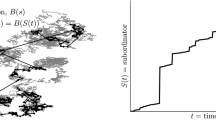Abstract
We resolve the long-standing problem of describing the multidimensional random evolutions by means of the telegraph equations. This problem was posed by Mark Kac more than 50 years ago and has become the subject of intense discussion among researchers on whether the multidimensional random flights could be described by the telegraph equations similarly to the one-dimensional case. We give the exhaustive answer to this question and show that the multidimensional random evolutions are driven by the hyperparabolic operators composed of the telegraph operators and their integer powers. The only exception is the 2D random flight whose transition density is the fundamental solution to the two-dimensional telegraph equation. The reason of the exceptionality of the 2D-case is explained. We also show that, under the standard Kac’s condition, the governing hyperparabolic operator turns into the generator of the Brownian motion.
Similar content being viewed by others
References
Bartlett, M.: A note on random walks at constant speed. Adv. Appl. Probab. 10, 704–707 (1978)
Goldstein, S.: On diffusion by discontinuous movements and on the telegraph equation. Q. J. Mech. Appl. Math. 4, 129–156 (1951)
Kac, M.: A stochastic model related to the telegrapher’s equation. Rocky Mt. J. Math. 4, 497–509 (1974)
Kolesnik, A.D.: The explicit probability distribution of a six-dimensional random flight. Theory Stoch. Process. 15(1), 33–39 (2009)
Kolesnik, A.D.: Random motions at finite speed in higher dimensions. J. Stat. Phys. 131, 1039–1065 (2008)
Kolesnik, A.D.: A four-dimensional random motion at finite speed. J. Appl. Probab. 43, 1107–1118 (2006)
Kolesnik, A.D., Orsingher, E.: A planar random motion with an infinite number of directions controlled by the damped wave equation. J. Appl. Probab. 42, 1168–1182 (2005)
Korolyuk, V.S., Swishchuk, A.V.: Semi-Markov Random Evolutions. Kluwer Academic, Amsterdam (1994)
Masoliver, J., Porrá, J.M., Weiss, G.H.: Some two and three-dimensional persistent random walks. Physica A 193, 469–482 (1993)
Papanicolaou, G.: Asymptotic analysis of transport processes. Bull. Am. Math. Soc. 81, 330–392 (1975)
Pinsky, M.A.: Lectures on Random Evolution. World Scientific, River Edge (1991)
Pinsky, M.A.: Isotropic transport process on a Riemannian manifold. Trans. Am. Math. Soc. 218, 353–360 (1976)
Stadje, W.: The exact probability distribution of a two-dimensional random walk. J. Stat. Phys. 46, 207–216 (1987)
Stadje, W.: Exact probability distributions for non-correlated random walk models. J. Stat. Phys. 56, 415–435 (1989)
Tolubinsky, E.V.: Theory of Transport Processes. Naukova Dumka, Kiev (1969) (in Russian)
Author information
Authors and Affiliations
Corresponding authors
Rights and permissions
About this article
Cite this article
Kolesnik, A.D., Pinsky, M.A. Random Evolutions Are Driven by the Hyperparabolic Operators. J Stat Phys 142, 828–846 (2011). https://doi.org/10.1007/s10955-011-0131-0
Received:
Accepted:
Published:
Issue Date:
DOI: https://doi.org/10.1007/s10955-011-0131-0



